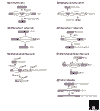Finding signals that regulate alternative splicing in the post-genomic era
- PMID: 12429065
- PMCID: PMC244920
- DOI: 10.1186/gb-2002-3-11-reviews0008
Finding signals that regulate alternative splicing in the post-genomic era
Abstract
Alternative splicing of pre-mRNAs is central to the generation of diversity from the relatively small number of genes in metazoan genomes. Auxiliary cis elements and trans-acting factors are required for the recognition of constitutive and alternatively spliced exons and their inclusion in pre-mRNA. Here, we discuss the regulatory elements that direct alternative splicing and how genome-wide analyses can aid in their identification.
Figures


References
-
- Charlet-B N, Savkur R, Singh G, Philips A, Grice E, Cooper T. Loss of the muscle-specific chloride channel in type I myotonic dystrophy lead to misregulated alternative splicing. Mol Cell. 2002;10:45–53. - PubMed
Publication types
MeSH terms
Substances
Grants and funding
LinkOut - more resources
Full Text Sources

